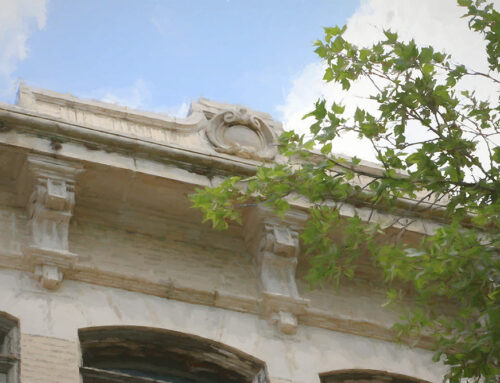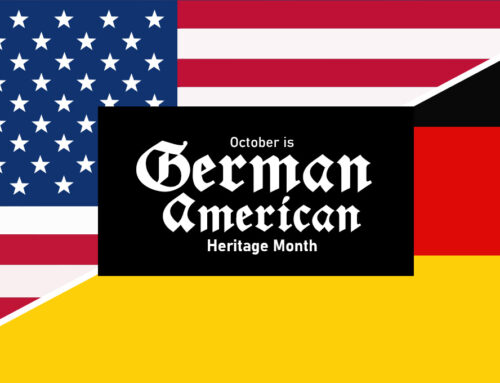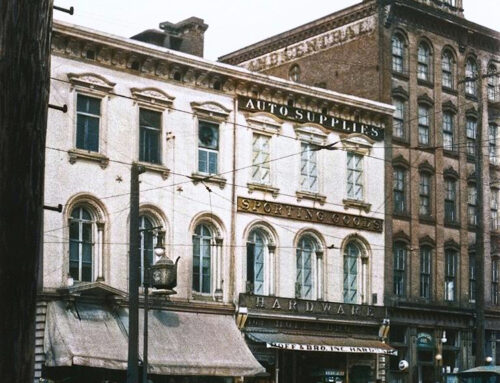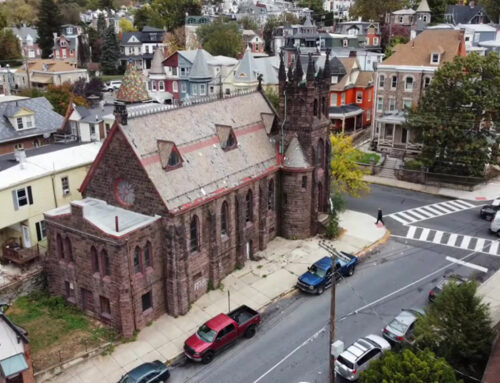One of the first business places in Reading was the store of Conrad Weiser at a little crossroads we now know as Fifth and Penn streets in Reading. Weiser moved to the Tulpehocken area in Pennsylvania in 1729, erecting a house upon a farmstead that would eventually contain 890 acres of land. In 1749 he purchased lot No. 3 of the original town plan of Reading, and obtained a patent in 1751. Under the conditions of sale, he erected a building on it in 1750 and established a trading post. The building was a small two-story log and stone structure, rough-plastered and white-coated, from which circumstance it derived the name of the “Old White Store,” by which it was extensively known. Conrad Weiser spent much of his time at his home in Reading, but nearly all of his official correspondence is dated from Tulpehocken and Heidelberg.
Below: The “Old White Store.”

Conrad Weiser was born in 1696 in the small village of Affstatt in Herrenberg, in the Duchy of Wurttemberg (now part of Germany). In 1709 his family was among thousands of refugees who left German lands that year after the land and people were ravaged by French invasions related to religious wars, and pestilence. They traveled down the Rhine River and then to England, which had offered some support for the Protestant refugees. The following year in 1710, the Crown (under Queen Anne) arranged for transport in ten ships of the nearly 3,000 Germans to the New York colony. Weiser senior moved his family to the Schoharie Valley of New York. When Conrad was 16, his father agreed to an Iroquois Indian chief’s proposal for the youth to live with the Mohawks in the upper Schoharie Valley. During his stay in the winter and spring of 1712-1713, Weiser learned much about the Mohawk language and the customs of the Iroquois, while enduring hardships of cold, hunger, and homesickness. Conrad Weiser returned to his own people towards the end of July 1713.
On November 22, 1720, at the age of 24, Weiser married Anna Eve Feck. In 1723 the couple followed the Susquehanna River south out of New York and settled their young family on a farm in Womelsdorf.
Weiser’s knowledge of the Iroquois was immediately employed as a diplomat to negotiate a series of land ownership treaties between the Pennsylvania colonists and the Indians. He had a hand in negotiating most treaties with the Indians between the 1730’s and the 1750’s. In 1737 he braved flood and famine to carry peace proposals from Virginia to the Six Nations. The journey, which proved Weiser’s courage and good will, impressed the Indians so much that they named him Tarachiawagon (The Holder of the Heavens), after the chief duty of the Iroquois.
In addition to serving as one of the most knowledgeable and successful liaisons between the Indian and the colonist, Weiser was chiefly responsible for both the settlement of the town of Reading and the establishment of Berks County.
Until 1758, he spent most of his time riding between Forts Northkill, Lebanon, and Henry in Berks County. Weiser conducted his final substantial contribution to Indian/Colonial diplomacy in 1758, negotiating the Treaty of Easton, which concluded the vast majority of Indian insurrection in the eastern third of Pennsylvania. He retired to his house in Reading after completion of this treaty and passed away on July 13, 1760.
Conrad Weiser is buried atop of a small hill to west of his which is believed to be his house in Womelsdorf (recent archaeological excavations bring into question whether or not this was Weiser’s home). His gravestone contains the following inscription, though it is almost illegible: This is the resting place of the once honored and respected Conrad Weiser who was born November 2d, A. D. 1696, in Afstaedt, County of Herrenberg, Wurtemberg, and died July 13th, A. D. 1760, aged 63 years, 8 months and 13 days.
In 1769 Nicholas Keim, an Oley Township farmer, commenced the hardware business on the ground formerly occupied by Conrad Weiser on Penn Street. Nicholas Keim was the son of Hans Keim, one of the first, if not the first, Germans to come to Berks County. Hans came to America in 1698. After spending some time in prospecting, Hans Keim returned to Europe the following year, 1699. In 1707 he came again to this country and brought along his wife, whom he had married the year before.
In 1785, Nicholas Keim turned the business over to his son, John Keim, who, in about 1800 formed a partnership with two of his sons, Daniel and George, to form the John Keim & Sons store. The Keim family conducted the hardware business until 1842 when they sold the property to Joseph L. Stichter and James McKnight.
James McKnight was the commander of the Ringgold Light Artillery, the first Pennsylvania Company to volunteer for service in the Civil War. Capt. James McKnight was later commissioned as a major in the regular army and served throughout the war.
Joseph Lybrand Stichter, son of Peter Stichter and his wife, Elizabeth Lybrand, was born in Reading, October 30, 1813. He received his education in the German and English schools of Reading, and when 15 years of age became an apprentice to the iron and hardware trade in the store of Keim & Drenkle.
Below: Joseph Lybrand Stichter.

He subsequently formed an engagement with the store of Daniel M. Keim & Co., which was continued up to the year 1837, when he entered into co-partnership with the late John M. Keim, under the firm of Keim & Stichter. In 1841, by the transfer of Mr. Keim’s interest to James McKnight, the title of the firm was changed to Stichter & McKnight. This connection was dissolved in 1858, by the retirement of the junior partner, and Mr. Stichter became sole proprietor of the business. In 1871, his son Thomas D. Stichter was admitted to partnership with his father to form J. L. Stichter & Son Hardware Store.
The original building underwent numerous enlargements and improvements under its successive owners, until it was finally destroyed by one of Reading’s greatest fires on January 16, 1872. It was on the morning of Tuesday, January 16, 1872, shortly after 2 o’clock, when the Court House bell struck seven taps, indicating that a fire had broken out in the Seventh ward. The fire originated from a stove in the rear of the Bast & Bros. Tobacco store, 15 North 5th Street. The flames were confined for a considerable time but in a few minutes the whole building was in flames. The firemen were prompt in responding, but the night was very cold and frozen plugs interfered with the operations of the firemen. The fire spread quickly to two of Reading’s landmarks, the old State House building on the northeast corner of Fifth and Penn; and the “Old White Store,” founded by Conrad Weiser occupied by Joseph L. Stichter & Son’s Hardware store. Between the two was the famous saloon and restaurant of “Dutch John” (Major John Ebner). At four o’clock the fire was extinguished. All the building were destroyed along with the Hoff & Millholland bank, a barber shop, a tobacco and cigar store, a drug store, a clothing store, and a restaurant. The Reading Fire Insurance Company’s building to the north was damaged, and the Reading Savings Bank, east of the Stichter building, was saved. Remarkably, the Stichter Hardware store was rebuilt in thirty days.
On May 21, 1884 Joseph L. Stichter died in his residence at 536 Penn street after becoming seriously ill a week earlier. Eight years later on July 24th, 1892, Joseph L. Stichter’s son, Thomas Diehl Stichter, who was only 45 years of age, died very suddenly of heart disease at his residence, 1369 Mineral Spring road.
On June 19, 1908 another fire destroyed the Stichter Hardware store. The fire broke out shortly before 3 o’clock a.m. in the building of the Stichter Hardware Company, 505 – 509 Penn street. Before the fire was extinguished, many hours afterwards, the structure was completely gutted.
Below: Joseph L. Stichter & Son’s Hardware Store before 1908 fire.


That the building was not again in ruins and that the flames did not spread to surrounding property was due to the efficient work of the fire department. As it was, the fire reached the cornice of the imposing Second National Bank building, which adjoins the Stichter building on Penn street, but the flames were fought back, and the only damage to the bank was from smoke on the fifth floor.
The Stichter Hardware Co. erected a new four-story structure at the same location, 505 – 509 Penn street. The building was constructed with a granite base and finished in brick and terra cotta. On June 22, 1909 Stichter Hardware Co. opened the enlarged new store.
On December 12, 1914, Thomas Diehl Stichter’s son, Joseph L. Stichter passed away. Stichter was a graduate of Sibley College in the Class of 1911. On March 21, 1925, the Stichter Hardware Company was incorporated under the name “Stichter Hardware Company, Inc.”
Mr. Stein, who had been with the Stichter Hardware Company for 46 years, and under whose management the business had prospered and grown, continued with the new corporation as general manager, and had been elected assistant treasurer of the corporation.
The Stichter Hardware Company and the other Penn Square stores did well until the 1960’s, when the suburbs that had been building since the end of World War II began demanding their own retailers. First the shopping centers and then the huge enclosed malls began springing up.
Slowly, the new suburban rivals sapped the strength of the downtown retailers, and they began closing.
On August 27, 1963 Stichter Hardware Co., Inc., announced that they were going out of the retail business, and was offering for sale its Penn Square property.
The Stichter Building was renovated in 1983.
A bronze tablet in the west wall of the former Stichter’s hardware store, Fifth and Penn Streets, Reading bears the following inscription:
“Posterity will not forget his services.” Washington
In memory of
Col. Conrad Weiser,
Pioneer, soldier, diplomat, judge. As interpreter and Indian agent he negotiated every treaty from 1732 until near the close of the French and Indian War.
The Weiser building where he often met the Indians in conference was erected by him on this site in 1751.
Born in Germany in 1696. Arrived in Berks in 1729. Died in 1760 near Womelsdorf, where his remains are buried.
His unswerving honesty set a shining example to future generations. Under the auspices of the Historical Society of Berks County this tablet was erected in 1907 by the school children of the county.
Made by Nat. Brass and Iron Wks, Reading Pa.
Erected 1907 by the School Children and Historical Society of Berks County
Below: Bronze tablet in the west wall Stichter Building, 505 Penn Street.

Below: Present Day Stichter Building.









Leave A Comment